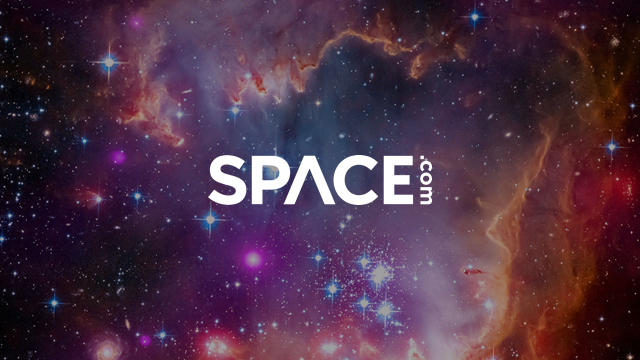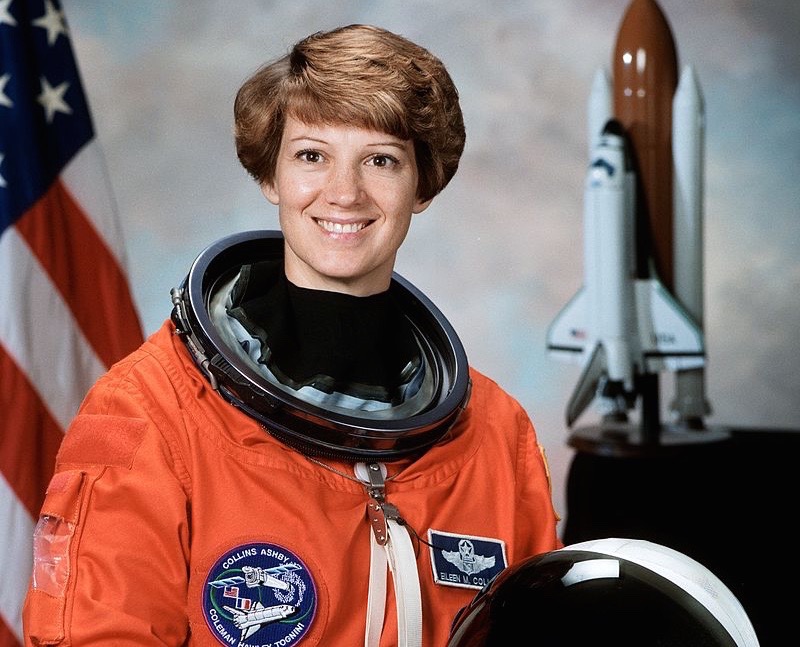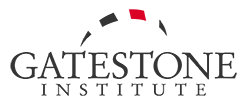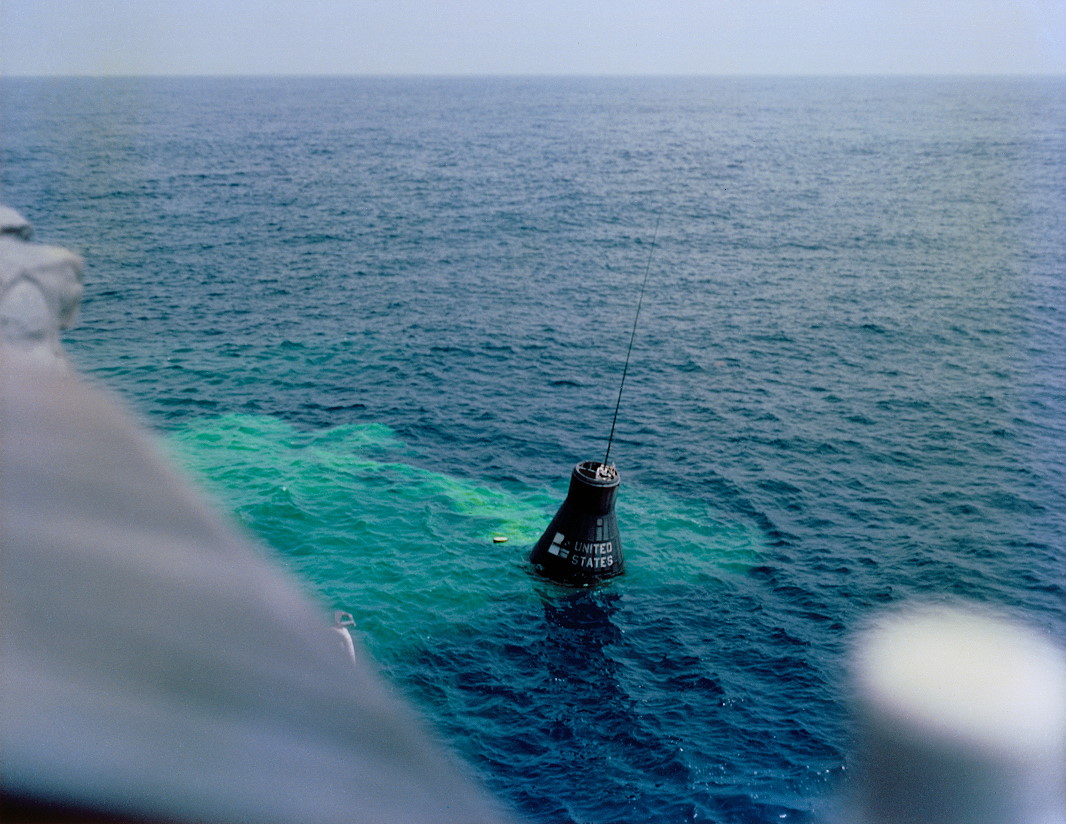
This was one of the final views of Liberty Bell 7 on 21 July 1961, before it was lost beneath the waves of the Atlantic Ocean. Not until 1999, more than three decades after Grissom's death, would the sunken capsule be returned to the surface. Photo Credit: NASA, via Joachim Becker/SpaceFacts.de
Fifty-five years ago, a small, tough, ex-fighter pilot named Virgil "Gus" Grissom became America's second man in space … and almost lost his life in a watery demise at its conclusion. As described in yesterday's AmericaSpace article, he had grown up with a determination to be the best and by April 1959 was selected as a member of the Mercury Seven. His space mission on 21 July 1961 lasted barely 15 minutes. Launched atop a Redstone missile, "Mercury-Redstone 4" would arc high above the Atlantic Ocean and splash down a couple of hundred miles east of Cape Canaveral. In that sense, it was a similar mission to that of America's first astronaut, Al Shepard, in May 1961. In several other senses, however, the two missions were poles apart.
For starters, Grissom's Mercury capsule—which he had nicknamed "Liberty Bell 7"—was the first of its kind to boast a large, trapezoid window, instead of two tiny portholes, which improved his field of view. A makeshift urine collector was also aboard, as was an explosively actuated side hatch. Early plans had called for the Mercury pilots to depart their craft through an antenna compartment in the capsule's nose, but this was so awkward that two hatches were developed: one manual, the other explosive. The hatch was held in place by 70 titanium bolts, each a quarter-inch in diameter, and a mechanical version was flown on Shepard's mission. However, it was three times heavier than its explosive counterpart. As a consequence, the explosive hatch was to be trialed on Grissom's mission. It was a decision which almost proved fatal.
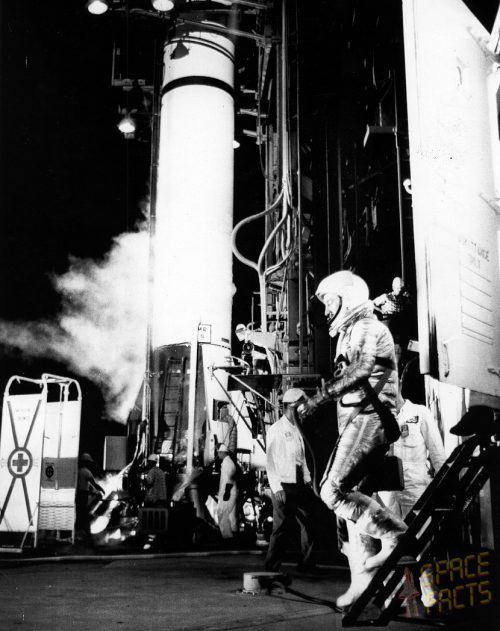
Grissom heads out to the Redstone booster in the small hours of 21 July 1961. Photo Credit: NASA, via Joachim Becker/SpaceFacts.de
The explosive hatch contained a mild detonating fuse, installed in a channel between an inner and outer seal around the edge of the hatch. When fired, the gas pressure between the two seals fractured each of the 70 bolts and blew off the hatch. Small holes, drilled into each bolt, provided "weak points" and aided the fracturing process. The fuse could be triggered manually by the astronaut himself, using a plunger close to his right arm, or from outside the capsule by means of an external lanyard. The performance of the hatch on the Liberty Bell 7 mission would, in some eyes, tarnish Grissom's reputation for the rest of his life and even today continues to arouse fierce debate.
During training, Grissom established his reputation as a "hands-on" pilot, attending meetings, supervising some of the engineering work and, he said, "fretting a little over whether all of the critical parts would arrive from the subcontractors on time and get put together." Among his concerns were mistakenly switched instruments, which caused the spacecraft to yaw to the left instead of the right, and the failure of the attitude controls, which did not properly center themselves after maneuvers. Throughout June 1961, nagging problems were encountered whilst testing his pressure suit and the spacecraft's rusted clock needed replacement. To ensure that he did not take himself out of the running for the mission, Grissom gave up water-skiing and calmed down some of his raucous exploits in his Corvette. As souvenirs for the flight, he took two rolls of Mercury dimes—a hundred in all—which he stuffed into the pocket of his suit. It was a decision that he would later live to regret.
Grissom's selection as the prime pilot for Liberty Bell 7, with John Glenn serving as backup, was ratified on 15 July 1961 and launch was scheduled for three days later. Part of what was becoming traditional was naming the capsule. Grissom's choice honored the famous Liberty Bell, today housed in Philadelphia, Penn., and considered one of the most important symbols of the American War of Independence. The Bell epitomizes freedom, nationhood, and the abolition of slavery. Cast in 1751, its most famous ringing, supposedly, occurred a quarter-century later to summon Philadelphia's citizenry for a reading of the Declaration of Independence.
When questioned, Grissom explained that the bell's message of freedom and similarity of shape with the spacecraft had influenced his decision. To further honor the original bell—which cracked during its first ringing, was repaired, cracked again in 1846, and was eventually rendered unusable—it was decided to paint a large white fracture along the side of the spacegoing Liberty Bell. "No one seemed quite sure what the crack looked like," said Grissom, "so we copied it from the tails side of a 50-cent piece."
On 17 July, the day before the planned launch, Grissom and Glenn relaxed in the crew quarters at Cape Canaveral's Hangar S. Late that same night, the launch was scrubbed by low cloud cover. This decision was taken before the lengthy procedure of loading the Redstone booster with liquid oxygen had begun. This meant that only a 24-hour delay, as opposed to a 48-hour stand-down, would be necessary. Physician Bill Douglas woke Grissom at 1:10 a.m. on 19 July and informed him that the scheduled launch time had been moved up by an hour, to 7 a.m., in the hope that the mission could be underway before a spell of bad weather settled over the Cape.
The plan was for Grissom to eat breakfast and undergo a physical examination. Unfortunately, the astronaut recalled later, "someone forgot to pass the word about the earlier launch time, because breakfast was not ready at 1:45 as it was supposed to be."
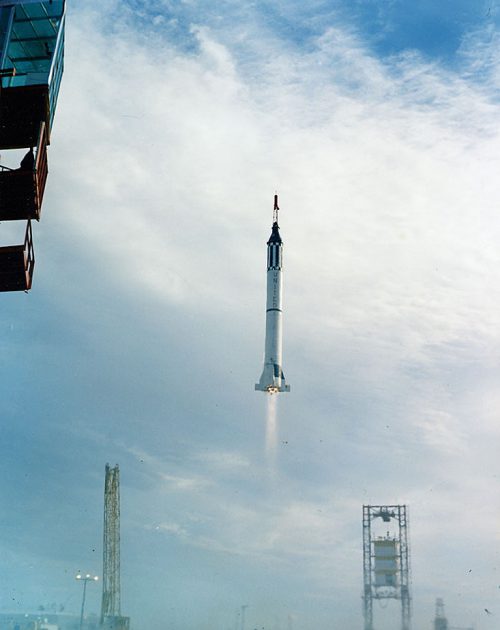
The Redstone was a converted weapon of war, retasked to deliver America's first two astronauts into space in May and July 1961. Photo Credit: NASA, via Joachim Becker/SpaceFacts.de
After the now-customary procedure of gluing sensors to his body, Grissom was helped into his pressure suit and, at 4:15 a.m., clambered into the white transfer van. Inside, technicians had helpfully stenciled a sign which read Shepard and Grissom Express. Despite the presence of cloudy skies along the entire Atlantic coast, "from Canaveral on north," the astronaut was given the go-ahead at 5 a.m. to board his spacecraft. To alleviate any boredom, Douglas handed Grissom a crossword book. The countdown, though, proceeded normally, albeit with a keen eye on the weather, until T-10 minutes, when the clock was stopped in the hope that conditions might improve.
They didn't.
The launch was scrubbed and, since the Redstone had been fully loaded with liquid oxygen, a 48-hour turnaround was now unavoidable. Early on 21 July, Grissom again suited-up and headed out to Pad 5. Delay after delay hit the countdown: firstly, one of the 70 titanium bolts around the rim of the hatch became cross-threaded, then the pad's searchlights had to be switched off to avoid interfering with telemetry from the rocket. All the while, cloud cover was given the opportunity to move away from the launch area. The astronaut, meanwhile, spoke briefly to his wife, did deep-breathing exercises, and flexed his arms and legs so as not to become too stiff.
At length, at 7:20:36 a.m., Liberty Bell 7 lifted-off.
Passing through the sound barrier, Grissom experienced none of the vibrations that had affected his predecessor, Al Shepard, and the Redstone's engine shut down, as planned, 142 seconds after liftoff. The astronaut felt a "brief tumbling sensation" at this stage and would later describe the clear sound of the escape tower being jettisoned. Two minutes after launch, at an altitude of 18 miles (30 km), Grissom noticed the sky turn rapidly from dark blue to black. He also noticed what he believed to be a faint star, roughly equally as bright as Polaris, but which actually turned out to be the planet Venus; this won him a steak dinner from John Glenn, who had bet him that he would not be able to see any stars or planets.
Observing Earth proved more difficult. Cloud cover over the Gulf of Mexico between Apalachiocola, Fla., and Mobile, Ala., made it virtually impossible for him to discern any land. Still, Grissom was granted a fascinating glimpse through the trapezoid window. "I could make out brilliant gradations of color," he said, "the blue of the water, the white of the beaches, and the brown of the land."
Re-entry posed no significant problems, with the exception that it gave Grissom the peculiar sensation that he had reversed his backward flight through space and was actually moving face-forward. Plummeting toward the Atlantic, he saw what appeared to be the spent retrorockets passing the periscope view. Nine minutes and 41 seconds after launch, the drogue chute deployed, slowing Liberty Bell 7, before the descent was arrested by the jolt of the main canopy. "The capsule started to rotate and swing slowly under the chute as it descended," he said later. "I could feel a slight jar as the landing bag dropped down to take up some of the shock." In spite of a small tear in the main canopy, it did its job, and the spacecraft impacted the Atlantic at 7:35 a.m., completing a mission of 15 minutes and 37 seconds—barely nine seconds longer than Shepard's flight—with what Grissom described as "a good bump." After splashdown, it nosed underwater, with the astronaut lying on his left side with his head down, but slowly righted itself as the impact skirt filled with water and acted as a sea anchor.
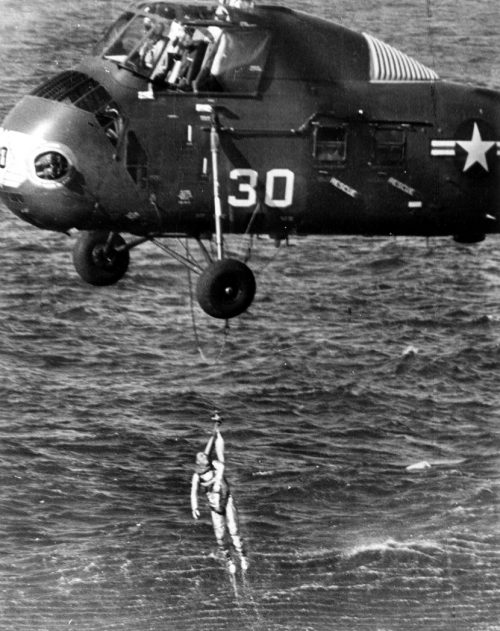
After several minutes in the water, and having come close to drowning, Grissom is winched out of the Atlantic to safety. Photo Credit: NASA, via Joachim Becker/SpaceFacts.de
He disconnected his oxygen inlet hose, unfastened his helmet from his suit, released the chest strap, lap belt and shoulder harness, and, finally, detached his biosensors. At first, he considered not bothering to unroll a rubber neck dam to keep air in and water out of his suit. "It's a chore to secure the dam," he said of the device, "and I didn't think I'd need it. Fortunately, I reconsidered."
As Grissom moved smartly through his post-landing checks, a quartet of Sikovsky UH-34D helicopters, dispatched from the recovery ship U.S.S. Randolph, were already on the scene. One of their crews, Jim Lewis and John Rinehard, had been tasked with raising Liberty Bell 7 from the water, after which the astronaut would explosively blow the hatch, exit the capsule and be winched aboard the chopper. Seconds after splashdown, Grissom radioed Lewis, callsigned "Hunt Club 1," to ask for a few minutes to finish marking switch positions. Finally, after confirming that he was ready to be picked up, he lay back in his couch and waited.
All at once, "I heard the hatch blow—the noise was a dull thud—and looked up to see blue sky … and water start to spill over the doorsill." The ocean was calm, but Mercury capsules were not designed for their seaworthiness, particularly with an open hatch, and Liberty Bell 7 started to wobble and flood. Grissom, who later admitted that he had "never moved faster" in his life, dropped his helmet, grabbed the right side of the instrument panel, jumped into the water, and swam furiously. "The next thing I knew," he said, "I was floating high in my suit with the water up to my armpits."
Although both cap and safety pin were off the detonator, Grissom later explained that he did not believe he had hit the button to manually blow the hatch. "The capsule was rocking around a little, but there weren't any loose items … so I don't know how I could have hit it, but possibly I did," he told a debriefing that morning aboard the Randolph. Lewis had to dip his helicopter's three wheels into the water to allow Rinehard to hook a cable onto the now-sinking Liberty Bell 7. "Fortunately," Lewis recounted, "the first time John tried, he managed to hook-up while the capsule was totally submerged." Grissom, now in the water, was puzzled, anxious, and then angry, when the helicopter did not lower a horse collar to hoist him aboard.
Lewis, whose own training had shown him that Mercury pressure suits "floated very well" and had seen the astronauts apparently enjoying their time in the water, had no idea that Grissom was in fact close to drowning. The astronaut had inadvertently left open an oxygen inlet connection, which allowed water to seep into his suit and air to leak out. Although he closed the inlet, some air also seeped from the neck dam, causing him to sink lower and regret the weight of souvenirs in his pockets.
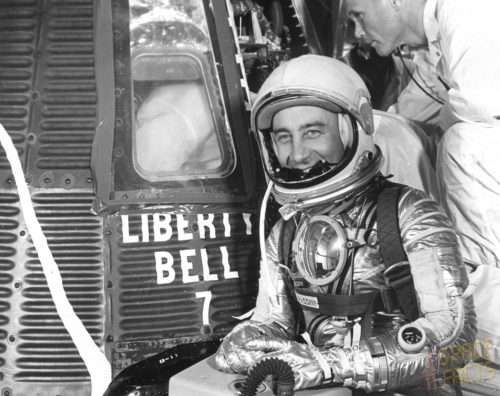
The white crack on the side of his capsule, paralleling that on the real Liberty Bell, is visible to the left of this pre-launch image of Virgil "Gus" Grissom. Photo Credit: NASA, via Joachim Becker/SpaceFacts.de
Grissom did not know that Lewis was himself struggling with the spacecraft: in addition to the waterlogged capsule, the landing bag had filled with seawater and it now weighed in excess of 4,400 pounds (2,000 kg)—some 1,100 pounds (500 kg) more than the helicopter was designed to lift. Although Lewis felt he could generate sufficient lift to raise Liberty Bell 7 and take it back to the Randolph, every time he pulled it clear of the water and it drained, a swell would rise and fill the capsule again. Lewis' instruments told him that the strain on the engine would allow him only five minutes in the air before it cut out. He therefore released the capsule to sink in 17,700 feet (5,400 meters) of water and requested that another chopper fish Grissom from the water while he nursed his own aircraft back to the ship.
Unaware of the difficulties the astronaut was having—they assumed that his frantic waving was to assure them that he was fine—it was several more minutes before the second helicopter, with George Cox aboard, dropped him a horse collar, which he looped around his neck and arms (albeit backwards) and lifted him to safety. Grissom was so exhausted that he could not even remember the helicopter had dragged him across the water before he finally started ascending. He had been in the water for only four or five minutes, "although it seemed like an eternity."
His first request upon arrival on the Randolph's deck was for something to blow his nose, as his head was full of seawater. A congratulatory call from President John F. Kennedy fell on deaf ears as, for the first time, "my aircraft and I had not come back together. In my entire career as a pilot, Liberty Bell 7 was the first thing I had ever lost."
Worse was to come. At his first post-mission press conference, and in the years to follow, Grissom would be grilled by journalists, not over the success of his mission, but over the festering question of whether he had contributed to the loss of his spacecraft by blowing the hatch. It was an accusation that Grissom would refute until the day he died.
Not surprisingly, his temperature and heart rate were both high when he arrived aboard the Randolph. Physicians described him as "tired and … breathing rapidly; his skin was warm and moist." Years later, in his book The Right Stuff, Tom Wolfe pointed to his physiological state as "evidence" that he had panicked inside Liberty Bell 7 … even though Grissom was known to have an abnormally high heart rate. Even the astronaut himself, at his first post-flight press conference in Cocoa Beach's Starlight Motel, admitted that he was "scared" during liftoff, an admission later jumped upon by the media as proof that America's second spaceman had displayed a chink of weakness. Test pilots at Edwards Air Force Base, Calif., scornfully mocked that Grissom had "screwed the pooch" and his sons were lambasted by their schoolmates for the loss of the capsule. In his own summary for Life magazine, Grissom admitted that "if a guy isn't a little frightened by a trip into space, he's abnormal."
A subsequent investigation from August to October 1961, which included fellow Mercury astronaut Wally Schirra, determined that the astronaut did not contribute in any way to the detonation of the hatch. Indeed, said Schirra, "there was only a very remote possibility that the plunger could have been actuated inadvertently by the pilot." During the inquiry, a fully-suited Schirra wriggled into a Mercury simulator and, no matter how hard he tried, could not "accidentally" trigger the hatch's detonator.
One of the conclusions was that a balloon would be installed in future capsules to allow recovery ships to pick up the spacecraft if the helicopters were forced to drop them. Many other engineers and managers shared the astronauts' conviction that Grissom was blameless. However, even though confidence in him remained high and he went on to command the first Gemini mission, the stigma refused to go away. Some engineers continued to mutter of "a transient malfunction," but had no way to identify it because the evidence lay on the floor of the Atlantic. Not until 1999 would Liberty Bell 7 be salvaged and raised to the surface.
Grissom himself participated exhaustively in the investigation. "I even crawled into capsules and tried to duplicate all of my movements," he said, "to see if I could make the whole thing happen again. It was impossible. The plunger that detonates the bolts is so far out of the way that I would have had to reach for it on purpose to hit it … and this I did not do. Even when I thrashed about with my elbows, I could not bump against it accidentally."
Moreover, to hit the plunger manually would have required sufficient force to produce a nasty bruise, which Grissom did not have. Possibilities explored over the years have included the omission of the ring seal on the detonator's plunger, static electricity from the helicopter, a change of temperature of the exterior lanyard after splashdown, or—a hypothesis that Grissom supported—the entanglement of the lanyard with the straps of the landing bag.
Certainly, launch pad leader Guenter Wendt fiercely discounted all of these theories but one: the entanglement of the exterior lanyard. "It is the most logical explanation," he said, but acquiesced "Can we prove it? No." It is a pity that the mishap—however it happened—should have, in the eyes of the public, marred what had otherwise been a hugely successful mission and which cleared the way for John Glenn's historic orbital flight in February 1962. Was the unfortunate, twice-cracked Liberty Bell to blame for its space-flying namesake's watery demise?
All Grissom would ever say was that Liberty Bell 7 "was the last capsule we would ever launch with a crack in it!"


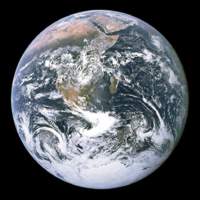
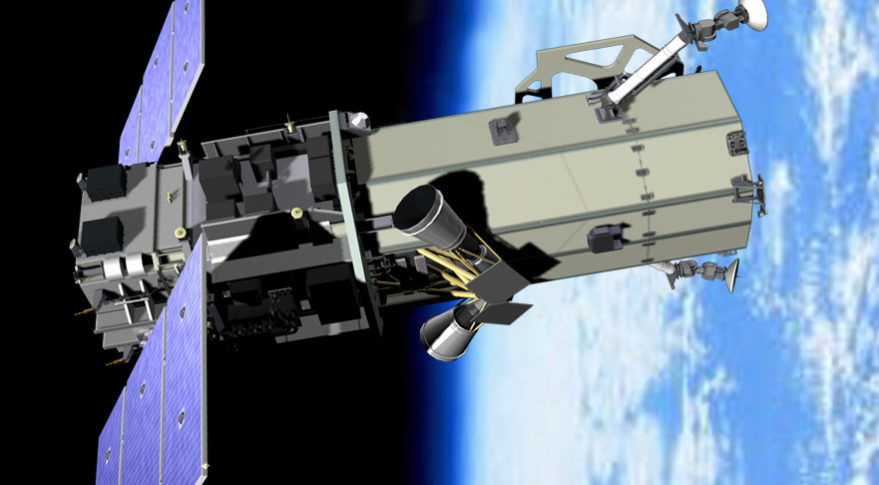 Artist's concept of DigitalGlobe's Worldview-2 satellite. Credit: Ball Aerospace
Artist's concept of DigitalGlobe's Worldview-2 satellite. Credit: Ball Aerospace 

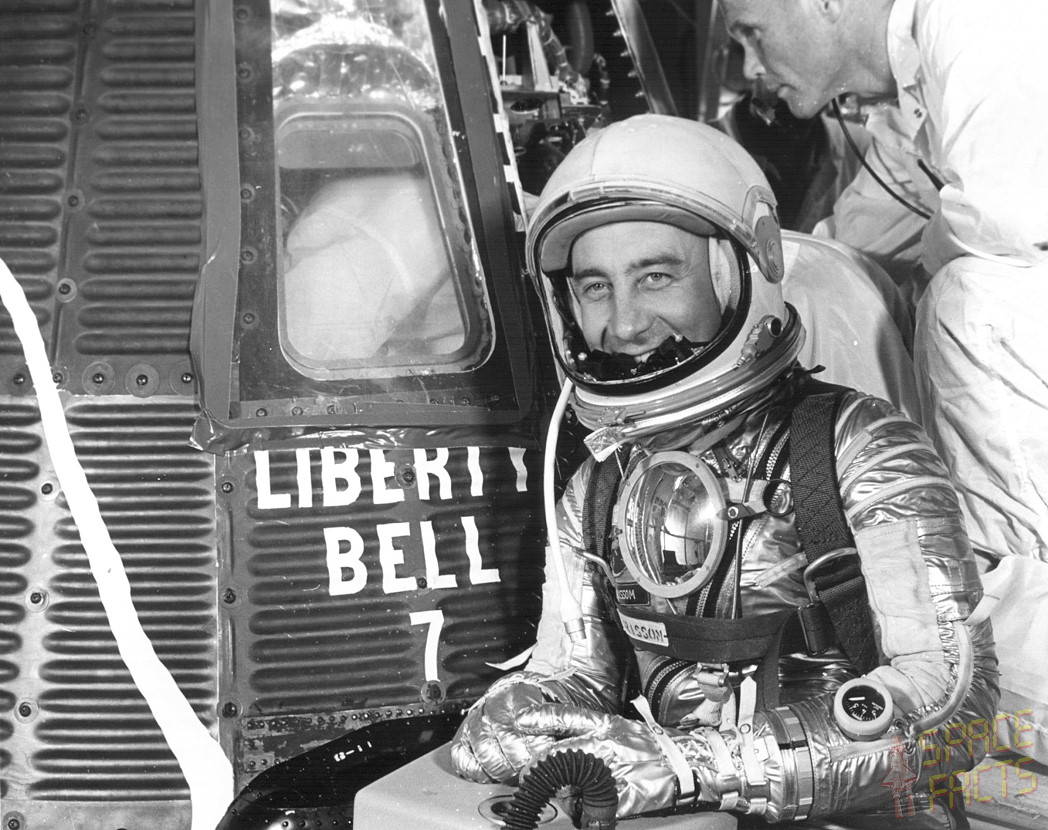
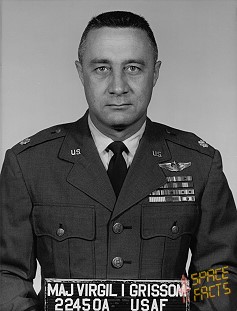
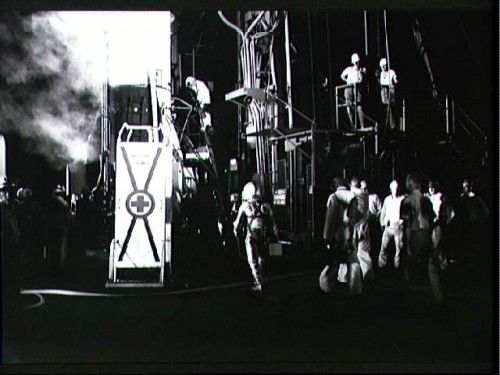









 Former astronaut Eileen Collins speaking at the Republican National Convention in Cleveland on July 20. Credit: RNC webcast
Former astronaut Eileen Collins speaking at the Republican National Convention in Cleveland on July 20. Credit: RNC webcast 